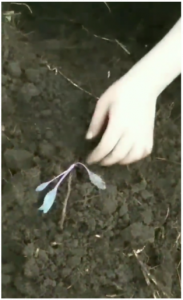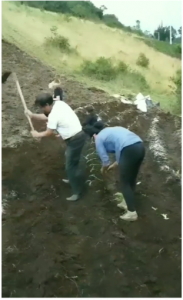By: Abigail Ayala Romero
The Yanapana Project was created as a joint effort by eight Ecuadorian students from three Canadian universities. As one of the founding members, I am writing this article to share our story. Yanapana Project officially launched in July 2020 after witnessing COVID 19’s impact on Ecuador’s less-resourced communities. The viral outbreak occurred just as many of us returned home after graduating. We saw that we could apply what we learned and experienced in college and give back to the community some of us belong to. We identified food insecurity and malnutrition as the crucial problem these groups face. After months of organizing, planning, and recruiting volunteers, we came up with a long-term sustainable project to empower vulnerable communities affected by food insecurity, and the Yanapana Project was born.[i]

Figure 1. Founding members and volunteers during the first visit to the neighbourhood of la Dolores in 2020. Photo by José Barahona.
Yanapana is a word from the Kichwa[ii] indigenous language that means ‘to help.’ Our mission is to “tackle the malnutrition problem that vulnerable groups of Ecuador face through Education, Solidarity, and Cooperation. We particularly aim to ensure that every person gets the opportunity to nurture their bodies, minds, and spirits.” [iii] We primarily work with pregnant mothers and children under the age of five since early stages of development have a significant impact on the rest of people’s lives.
Since September 2021, we have provided 2,520 meals to beneficiary families. This is achieved by delivering food baskets with fresh produce from a local market that provides three meals for seven people per day. In addition to the food, the Yanapana Project also offers nutritional guidance to the beneficiary families. And in partnership with an organization called DeBase, we are building a community garden in the neighborhood we are currently supporting called La Dolores. Such support is helping to empower the 84 families that make up the community of La Dolores. For instance, Doña Marlene now has a stable food source for her family and herself.
- Figure 2. Grandson of the first beneficiary family of La Dolores. Photo by Pamela Chávez
- Figure 3. La Dolores residence. Photo by José Barahona.
Yanapana is organized by varying specialties and is led by 70 amazing volunteers. Each volunteer’s work differs from one another. For example, those working in human resources recruit new volunteers and organize events for all Yanapana members. Others on the marketing team design content for our social media channels. Logistic volunteers deliver the food baskets and nutritional brochures to the beneficiary families. And the nutritional team determines which foods are included in the baskets.
As a founding member, my roles vary. I often reach out to donors for funding, attend virtual meetings to help organize volunteers, and visit La Dolores weekly. A typical Sunday of work begins at 9 am. I start by meeting with my external relations volunteer team on Zoom. We discuss how we can expand our partnerships with social collectives, for-profit, and not-for-profit organizations to maintain financial support for Yanapana. Such efforts have led to fundraising events such as garage sales. And in December 2021, we participated in two flea markets by selling donated second-hand clothes, books, and other household items. All the money we earned went directly to fund the food baskets and the La Dolores community garden development.

Figure 4 .Volunteers at our stand during the first flea market we participated in for December 2021. Photo by Abigail Ayala
On days that I visit La Dolores, I help the community work the land. Together, we weed the soil, collect organic waste for compost, and plant more vegetables if we need to. So far, we have planted lettuce, radish, potatoes, corn, broad beans, onions, broccoli, spinach, carrots, mint, among more legumes and vegetables. Then, around 2 pm, we chat and share lunch. Finally, at around 3 pm, I say goodbye to everyone and drive home.
- Figure 5. Volunteer planting beetroot. Photo by Abigail Ayala
- Figure 6. DeBase member and La Dolores community member planting onions. Photo by Abigail Ayala
In the evenings, the board of directors holds its weekly Zoom meeting. This is the opportunity for all directors to provide updates on their team’s progress and discuss improving Yanapana. For example, we are currently developing a local food market that will sell the produce harvested from the community garden. I envision this project growing to support communities experiencing malnutrition all over Ecuador sustainably.

Figure 7. Directors and volunteers at the first in person fundraising event. Photo by Pablo Ayala
To learn more about Yanapana Project you can visit www.yanapanaproject.org or follow us on Facebook: (20+) Yanapana Project | Facebook
Instagram: Yanapana Project EC (@yanapana_project) • Instagram photos and videos
and Linked In: https://www.linkedin.com/company/yanapana-project
[i] We engaged Luis Simbaña’s bachelor’s thesis as the primary source to understand food insecurity and malnutrition in Ecuador. We also benefited from following resources:
- Walrod, Jemie, Erica Seccareccia, Iván Sarmiento, Juan Pablo Pimentel, Shivali Misra, Juana Morales, Alison Doucet, and Neil Andersson. “Community Factors Associated with Stunting, Overweight and Food Insecurity: A Community-Based Mixed-Method Study in Four Andean Indigenous Communities in Ecuador.” BMJ Open8 (7): e020760. https://doi.org/10.1136/bmjopen-2017-020760.
- Ruiz Polit, Pamela, & Sarita Lucila Betancourt Ortiz. “Sobre la anemia en las edades infantiles en el Ecuador: Causas e intervenciones correctivas y preventivas.” Revista Cubana de Alimentación y Nutrición[En línea], 30.1 (2020): 18. Web. 11 ene. 2022
- https://www.unicef.org/ecuador/desnutrici%C3%B3n
- Ecuador registra índices de desnutrición en niños y obesidad en adultos | La República EC (larepublica.ec)
[ii] Kichwa is the second official language in Ecuador. All Ecuadorian’s use words in Kichwa in our daily communication. The La Dolores community, however, does not identify as Kichwa nor do they speak it fluently.
[iii] Citation taken from Yanapana Project’s website.



